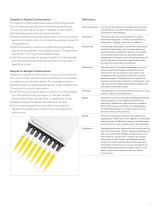
Catalog excerpts

Application Note April 27, 2018 Keywords or phrases: Pipetting, contamination, cross-contamination, sample preparation, filter tips, sterile tips How to Avoid Contamination in Pipetting Joni Ake1 * 1. Sartorius Biohit Liquid Handling Oy, Laippatie 1, 00880 Helsinki * Correspondence E-Mail: Joni.Ake@sartorius.com Introduction Preventing contamination in pipetting is paramount to achieving reliable results. It requires identification of the potential contamination mechanisms in order that they can all be addressed. Aerosols, suspensions of solid or liquid particles in a gas, are formed in many laboratory activities such as pipetting with air displacement pipettes, and aerosols are the major contamination source in pipetting. They may transfer into the pipette body when unfiltered pipette tips are used and consequently contaminate subsequent samples. A slow and careful pipetting rhythm helps minimize aerosol formation. This paper addresses the three contamination types that originate from pipetting: pipette-to-sample contamination, sample-topipette contamination, and sample-to-sample contamination. Find out more: www.sartorius.com
Open the catalog to page 1
Pipette-to-Sample Contamination This type of contamination occurs when a contaminated pipette or pipette tip contaminates the sample. Pipette tips are available in multiple purity grades from most manufacturers. Purity grades can be divided into three categories: no purity certification certified free of contaminants like DNase, RNase, and endotoxins sterilized to be free of microbial life Contaminants such as DNase, RNase, and endotoxins are difficult to remove by any sterilization method, so it is very important to prevent contamination during manufacturing. The absence of these...
Open the catalog to page 2
Sample-to-Pipette Contamination This type of contamination takes place when the pipetted liquid or aerosol particles from it enter the pipette body. To minimize the risk of sample-to-pipette contamination, the following precautions are recommended: Always release the pipette’s push button slowly to prevent aerosol formation and uncontrolled liquid splashing within the pipette tip. Hold the pipette in a vertical position during pipetting and store the pipette in an upright position. This prevents liquids from running into the pipette body. Use filter tips to prevent aerosol transfer from the...
Open the catalog to page 3
Germany Sartorius Lab Instruments GmbH & Co. KG Otto-Brenner-Strasse 20 37079 Goettingen Phone +49 551 308 0 For further contacts, visit Specifications subject to change without notice. Copyright Sartorius Lab Instruments GmbH & Co. KG. Order No.: 85037-550-68 Publication No.: SUL1002-e Status 07 | 2020
Open the catalog to page 4All Sartorius Group catalogs and technical brochures
-
OEM
52 Pages
-
Octet® R2 System
7 Pages
-
Unisart® CN 180 DX Membrane
4 Pages
-
Pipette Cleaning
1 Pages
-
continuous air monitoring
6 Pages
-
Pipette Essentials
2 Pages
-
ABC of pipette tips
1 Pages
-
Vivaflow®
12 Pages
-
Vacusart
2 Pages
-
Sterisart® Sterility Testing
6 Pages
-
Sterisart® NF
4 Pages
-
Sterisart® Family
12 Pages
-
Speedcal Mobile
2 Pages
-
Sartocheck® 5 Plus Filter Tester
26 Pages
-
Rline® Dispenser Module
4 Pages
-
Quintix® and Secura®
24 Pages
-
Picus® and Picus® NxT
8 Pages
-
Midi Plus Pipette Controller
4 Pages
-
Microbiological QC Solutions
12 Pages
-
MA160 Moisture Analyze
8 Pages
-
Filter Papers
36 Pages
-
Cubis® II
12 Pages
-
Claristep® Filtration System
12 Pages
-
Arium® Mini
11 Pages
-
Ultrafiltration Family
96 Pages























































